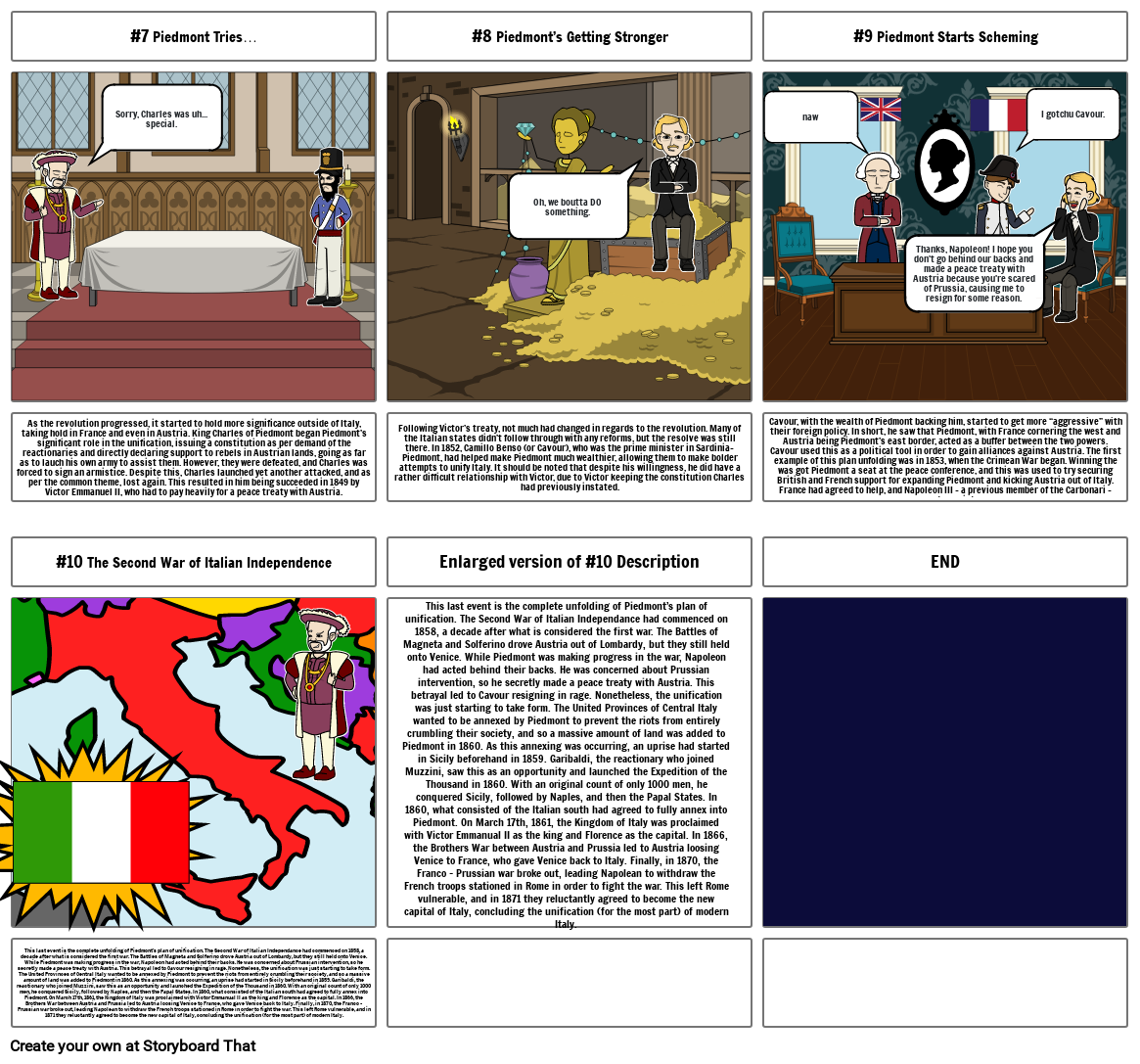Italian Unification (slides #7 - #10)

Storyboard Text
- #7 Piedmont Tries…
- Sorry, Charles was uh... special.
- #8 Piedmont’s Getting Stronger
- Oh, we boutta DO something.
- #9 Piedmont Starts Scheming
- naw
- Thanks, Napoleon! I hope you don't go behind our backs and made a peace treaty with Austria because you're scared of Prussia, causing me to resign for some reason.
- I gotchu Cavour.
- As the revolution progressed, it started to hold more significance outside of Italy, taking hold in France and even in Austria. King Charles of Piedmont began Piedmont’s significant role in the unification, issuing a constitution as per demand of the reactionaries and directly declaring support to rebels in Austrian lands, going as far as to lauch his own army to assist them. However, they were defeated, and Charles was forced to sign an armistice. Despite this, Charles launched yet another attacked, and as per the common theme, lost again. This resulted in him being succeeded in 1849 by Victor Emmanuel II, who had to pay heavily for a peace treaty with Austria.
- #10 The Second War of Italian Independence
- Following Victor’s treaty, not much had changed in regards to the revolution. Many of the Italian states didn’t follow through with any reforms, but the resolve was still there. In 1852, Camillo Benso (or Cavour), who was the prime minister in Sardinia-Piedmont, had helped make Piedmont much wealthier, allowing them to make bolder attempts to unify Italy. It should be noted that despite his willingness, he did have a rather difficult relationship with Victor, due to Victor keeping the constitution Charles had previously instated.
- Enlarged version of #10 Description
- This last event is the complete unfolding of Piedmont’s plan of unification. The Second War of Italian Independance had commenced on 1858, a decade after what is considered the first war. The Battles of Magneta and Solferino drove Austria out of Lombardy, but they still held onto Venice. While Piedmont was making progress in the war, Napoleon had acted behind their backs. He was concerned about Prussian intervention, so he secretly made a peace treaty with Austria. This betrayal led to Cavour resigning in rage. Nonetheless, the unification was just starting to take form. The United Provinces of Central Italy wanted to be annexed by Piedmont to prevent the riots from entirely crumbling their society, and so a massive amount of land was added to Piedmont in 1860. As this annexing was occurring, an uprise had started in Sicily beforehand in 1859. Garibaldi, the reactionary who joined Muzzini, saw this as an opportunity and launched the Expedition of the Thousand in 1860. With an original count of only 1000 men, he conquered Sicily, followed by Naples, and then the Papal States. In 1860, what consisted of the Italian south had agreed to fully annex into Piedmont. On March 17th, 1861, the Kingdom of Italy was proclaimed with Victor Emmanual II as the king and Florence as the capital. In 1866, the Brothers War between Austria and Prussia led to Austria loosing Venice to France, who gave Venice back to Italy. Finally, in 1870, the Franco - Prussian war broke out, leading Napolean to withdraw the French troops stationed in Rome in order to fight the war. This left Rome vulnerable, and in 1871 they reluctantly agreed to become the new capital of Italy, concluding the unification (for the most part) of modern Italy.
- Cavour, with the wealth of Piedmont backing him, started to get more “aggressive” with their foreign policy. In short, he saw that Piedmont, with France cornering the west and Austria being Piedmont’s east border, acted as a buffer between the two powers. Cavour used this as a political tool in order to gain alliances against Austria. The first example of this plan unfolding was in 1853, when the Crimean War began. Winning the was got Piedmont a seat at the peace conference, and this was used to try securing British and French support for expanding Piedmont and kicking Austria out of Italy. France had agreed to help, and Napoleon III - a previous member of the Carbonari - came to assist.
- END
- This last event is the complete unfolding of Piedmont’s plan of unification. The Second War of Italian Independance had commenced on 1858, a decade after what is considered the first war. The Battles of Magneta and Solferino drove Austria out of Lombardy, but they still held onto Venice. While Piedmont was making progress in the war, Napoleon had acted behind their backs. He was concerned about Prussian intervention, so he secretly made a peace treaty with Austria. This betrayal led to Cavour resigning in rage. Nonetheless, the unification was just starting to take form. The United Provinces of Central Italy wanted to be annexed by Piedmont to prevent the riots from entirely crumbling their society, and so a massive amount of land was added to Piedmont in 1860. As this annexing was occurring, an uprise had started in Sicily beforehand in 1859. Garibaldi, the reactionary who joined Muzzini, saw this as an opportunity and launched the Expedition of the Thousand in 1860. With an original count of only 1000 men, he conquered Sicily, followed by Naples, and then the Papal States. In 1860, what consisted of the Italian south had agreed to fully annex into Piedmont. On March 17th, 1861, the Kingdom of Italy was proclaimed with Victor Emmanual II as the king and Florence as the capital. In 1866, the Brothers War between Austria and Prussia led to Austria loosing Venice to France, who gave Venice back to Italy. Finally, in 1870, the Franco - Prussian war broke out, leading Napolean to withdraw the French troops stationed in Rome in order to fight the war. This left Rome vulnerable, and in 1871 they reluctantly agreed to become the new capital of Italy, concluding the unification (for the most part) of modern Italy.
Over 30 Million Storyboards Created

